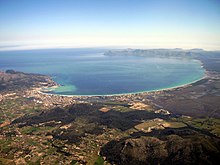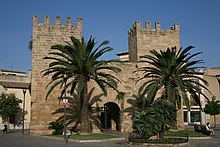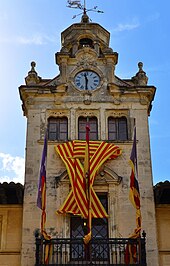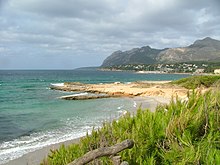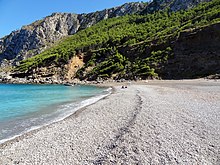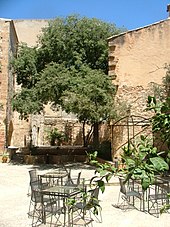Alcúdia
| Alcúdia municipality | ||
|---|---|---|
| coat of arms | Map of Spain | |
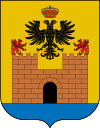
|
|
|
| Basic data | ||
| Autonomous Community : | Balearic Islands | |
| Island: | Mallorca | |
| Comarca : | Raiguer | |
| Coordinates | 39 ° 51 ′ N , 3 ° 7 ′ E | |
| Height : | 15 msnm | |
| Area : | 59.89 km² | |
| Residents : | 20,241 (Jan. 1, 2019) | |
| Population density : | 337.97 inhabitants / km² | |
| Postal code : | 07400 | |
| Municipality number ( INE ): | 07003 | |
| Nearest airport : | Palma ( Son Sant Joan / Palma de Mallorca , 55 km ) | |
| administration | ||
| Official language : | Catalan , Castilian | |
| Mayor : | Antoni Mir Llabrés ( PI ) | |
| Website : | www.alcudia.net | |
| Location of the municipality | ||
Mallorca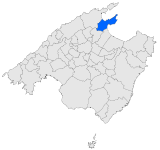
|
||
Alcúdia is a municipality on the Spanish Balearic island of Mallorca . The small town of the same name is the administrative seat of the municipality in the region ( comarca ) Raiguer .
The municipality of Alcúdia has 20,241 inhabitants (as of January 1, 2019) on an area of 59.89 km². This corresponds to 338 inhabitants per km². In 2006 the proportion of foreigners was 25.5% (4128), the proportion of German residents 3.1% (499). The official languages are Catalan and Spanish (Castilian). The spoken on the island Catalan dialect is Mallorquí called.
The name Alcúdia comes from the Arabic “Al-Qudya” and means “the hill”, which indicates the location of the historic city center, which lies on the saddle between the Bay of Pollença and the Bay of Alcúdia, separated by a flat mountain range are separated.
geography
Geographical location
The municipality of Alcúdia is located 54 kilometers from the island's capital Palma on the opposite northeast coast of the island. It forms the north-east of the Raiguer landscape and consists of the peninsula of Cap des Pinar (also called Victòria ), which divides the bays of Pollença and Alcúdia, and a zone of the interior of the island, delimited by the municipalities of Pollença in the north and Sa Pobla and Muro in the South. The city of Alcúdia is located roughly in the middle of the municipality, exactly between the two bays Badia de Pollença and Badia d'Alcúdia at the end of the peninsula. Your port of Port d'Alcúdia , now a tourist resort , is located in the south of the city on the Bay of Alcúdia . The municipality's coastline is around 30 kilometers long.
Community structure
The following places belong to the municipality of Alcúdia:
- Alcúdia (6328/6647 inhabitants)
- Mal Pas - Bonaire (599/611 inhabitants)
- Marina Manresa (595/596 inhabitants)
- Platja d'Alcúdia (5306/5340 inhabitants)
- Port d'Alcúdia (4745/4772 inhabitants)
- Son Fe (- / 361 inhabitants)
The population figures in brackets are from January 1, 2008. The first number indicates the residents of the built-up areas, the second number the residents of the towns, including the “scattered” population outside the actual settlements. (Source: INE )
Natural space
The urbanized area of the city of Alcúdia and the southern port of Port d'Alcúdia on the isthmus between the bays Badia de Pollença and Badia d'Alcúdia divides the municipality into two different natural spaces. To the east, the Victòria peninsula on sa Talaia ( Talaia d'Alcúdia ) rises to a height of 444 meters above sea level . Today's peninsula was formed as a rocky island in the Quaternary and is very rugged. Their partial inaccessibility led to only sparse settlement, so that the mountainous massif is still made up of holm oaks and pines .
To the west of the city of Alcúdia lies a plain made of alluvial material from the sea, which over time has connected the Victòria peninsula with the rest of Mallorca. The s'Albufereta , which borders Pollença to the north, is still a low-lying wetland, albeit consisting of fresh water. The plains are used as arable land. Only a few elevations on the southern chain of hills are excluded, such as Puig de Sant Martí (247 meters high), Puig de sa Galera (123 meters) and Puig de Son Fè (268 meters).
climate
Alcúdia has a mild subtropical climate. The average temperature of the year is 16.8 ° C with average highs of 20.5 ° C and lows of 13.4 ° C. The mean values for the different seasons are 14.5 ° C in spring, 23.5 ° C in summer, 18.6 ° C in autumn and 10.7 ° C in winter. The mean water temperatures, measured in the Bay of Alcúdia , are 18.5 ° C, with maximum values in August of 25.7 ° C and the lowest temperatures in February of up to 12.3 ° C.
The municipal area is largely protected from north and west winds by the mountain range of the Serra de Tramuntana, with north-east and east winds predominating. Since many low pressure areas already rain down on the Serra de Tramuntana , there are only an average number of 82 rainy days per year in Alcúdia with an average rainfall of 536 l / m². The summers in particular can be described as very dry.
|
Average monthly temperatures and rainfall for
Source: climate-data.org , klima.org
|
|||||||||||||||||||||||||||||||||||||||||||||||||||||||||||||||||||||||||||||||||||||||||||||||||||||||||||||||||||||||||||||||||||||||||||||||||||||||||||||||||||||||||||||||||||||||||||||||||||||||||||||||||||||||||||||||||||||||||||||||||||||||||||||||
history
Archaeological finds show that the area of the municipality of Alcúdia as early as 2000 BC. Was settled. From the time to 1300 BC In BC, the so-called pre-Talaiotic , artificially created caves are known that were used for burial purposes, such as the Cova de la Murada near the medieval city wall of Alcúdia or the two caves inside the rows of spectators ( càvea ) of the Teatre Romà of Pollentia . From Talaiotic times that span the period from 1300 BC. BC to 123 BC The large stone buildings of Son Siurana de Dalt , Son Simó , Biniatria , Oriolet and sa Figuera Roja have been partially preserved.
After the conquest of Mallorca and the entire Balearic Islands in 123 BC. BC by the Roman troops under consul Quintus Caecilius Metellus Balearicus (also: Cecili Metel) it came about 70 BC due to the strategically favorable location. BC to found the city of Pollentia ( Catalan Pol·lèntia), immediately south of the current city walls of Alcúdia. The city flourished for a long time as the capital of Maiorica and the Roman province of Balearica until it was sacked and destroyed by the Vandals in AD 426 . Pollentia is said to have been partially populated even afterwards, during the rule of the Vandals from 465 AD and the Byzantines from 534 AD.
In the centuries between 902 and 1229, the Moors and Arabs ruled the islands of the Balearic Islands, including Mallorca. The town or settlement of Pollentia no longer existed at that time. Instead, the design of today's Alcúdia, as well as the name of the city, which translates as "the hill", go back to Muslim rule. However, at the time of the Aragonese conquest of the island in 1229 by King James I of Aragon (Catalan Jaume I el Conqueridor ), the place existed only as an estate, which the king ceded to a vassal named Ruí Peris. A settlement soon formed around the Alcúdia estate, which was first mentioned under this name under this name in a notarial protocol from 1282, and became a parish and center of one in 1298 by King James II of Mallorca ( Jaume II. De Mallorca ) Administrative area was raised. The construction of the church (from 1302) and the old city wall (from 1298), which was completed in 1362 and parts of which are still preserved, such as the two city gates Porta de Sant Sebastià (also called Porta de Mallorca ) and, go back to this time Porta del Moll (also Porta de Xara ).
In the centuries that followed, Alcúdia was an important center of power in the north of Mallorca. Under King Charles I of Spain from the House of Habsburg , who later became Emperor Charles V of the Holy Roman Empire , Alcúdia was named a city in 1523 with the associated privileges. The Habsburg double-headed eagle still adorns the city's coat of arms today . The reason for the granting of city rights for Alcúdia was the support of the king in the suppression of the Revolta de les Germanies , an uprising of the urban guilds in alliance with the peasants against high taxes and the feudal lords. Starting in Valencia , the revolt had spread to Mallorca in 1521, where the "Agermanados" (guild brothers) ruled for two years in Palma under their leader Joan Crespí , later the peasant leader Joanot Colom . The nobles withdrew to the fortified town of Alcúdia, from where an army supported the king in taking Palma in 1522.
In the 16th century, Alcúdia was hit by pirate attacks several times, after which the city walls were extended by a second wall ring in the Renaissance style until 1660 . Subsequently, the city lost its economic importance, which was also noticeable in the considerably declining population in the 18th and 19th centuries, also as a result of epidemics , including the plague . Even the expansion of the port for international trade in 1779 could not prevent this. Significantly, the old parish church from the 14th century collapsed in 1870. It was not rebuilt until 1882 and was given its present appearance until 1893.
The economic situation only improved with the beginnings of tourism in the 1930s and the construction of the coal-fired power station to supply Mallorca with electricity in the port of Alcúdia in 1957, which with its silhouette of two tall chimneys still shapes the cityscape from afar. In the 1980s, the old coal-fired power station was shut down and a new, more efficient coal-fired power station was built outside the tourist zone. It was created at the end of a specially newly built ring road around the hotel areas from the port to the cul-de-sac to Sa Pobla, a residential area reserved for local Mallorcans in the middle of the vegetable growing region directly south of the Albufera recreation area. The old power plant is to be converted into one of the most modern museums in Spain.
| year | 1842 | 1877 | 1887 | 1900 | 1910 | 1920 | 1930 | 1940 | 1950 | 1960 | 1970 | 1981 | 1991 | 2001 | 2011 |
|---|---|---|---|---|---|---|---|---|---|---|---|---|---|---|---|
| Residents | 1,120 | 2,271 | 2,637 | 2,718 | 3,101 | 3,504 | 3,683 | 3,782 | 3,573 | 3,487 | 3,899 | 5,350 | 8,027 | 12,500 | 19,243 |
Culture and sights
Churches and monasteries
Església de Sant Jaume
The parish church of Sant Jaume (Església Parroquial) of Alcúdia, built in neo-Gothic style, stands on the southwest edge of the old town in a gap in the city wall. It was built between 1882 and 1893 after the previous building from the 14th century collapsed in 1870. The church is dedicated to Saint Jacob .
Sant Crist
In addition to the current parish church of Sant Jaume , the chapel of the miraculous Christ has been preserved from the previous building. It was built in the Renaissance style between 1675 and 1697. The statue of Christ venerated there is a wooden figure from the period before 1507, the top of the main altar comes from the Baroque era .
Oratori de Santa Anna
The small Gothic church of St. Anne south of the city walls on Carretera Cementiri is a building from the 13th century. Above the entrance there is a portrait of Our Lady of the Happy Message ( Verge de Bona Nova ). The low nave is supported by three partition arches that divide the interior into four segments.
Ermita de la Victòria
The Mare de Déu de la Victòria ( Our Lady of Victory ) hermitage dates back to the 13th century. In 1697 the small church with a three-part nave and arched vault was built in the Baroque style. The carved figure of the Mare de Déu dates from the 15th century, the large altar, like the church, from the Baroque period. The church was restored at the beginning of the 18th century. The Ermita is a place of pilgrimage on July 2nd every year.
Theaters and cultural centers
Auditori d'Alcúdia
The cultural center (auditorium), inaugurated on July 8, 2000, offers space for concerts, theater, exhibitions, celebrations and congresses. It has a hall for 496 people and a smaller hall for up to 50 people. The Auditori d'Alcúdia is located on Plaça de la Porta de Mallorca near the city wall.
Museums
Museu monogràfic de Poŀlèntia
The Museu monogràfic de Poŀlèntia mainly shows finds from excavations in the ancient Roman city of Pollentia . It is located in downtown Alcúdia on Carrer Sant Jaume 30 . Grave goods, ceramic and bronze vessels from different eras, glasses, amphorae, coins, stone tablets, marble work and mosaics are on display. The Consorci de la Ciutat Romana de Poŀlèntia offer group tours both through the museum and the excavation sites south of the old town of Alcúdia.
Fundació Yannick i Ben Jakober
The collection of children's portraits from the 16th to 19th centuries, housed in a former water reservoir in Finca sa Bassa Blanca , also shows sculptures by the artists Ben Jakober and Yannick Vu in the open air .
Museu Parroquial de Sant Jaume
The small museum of the parish church of Sant Jaume on Plaça Jaume Ques exhibits, among other things, sacred robes from the history of the parish.
Buildings
- Archaeological excavations of the Roman city of Pollentia
- Historic city center
- City fortifications of Alcúdia
- Alcúdia Town Hall
- Decommissioned coal power plant
- Bullring Alcúdia
caves
Cova de Sant Martí
The cave of Sant Martí is a natural rock cave at the southern foot of the 247 meter high mountain Puig de Sant Martí . It was used as a place of worship in early Christian times. After the conquest of Mallorca by the Crown of Aragon , two Gothic-style chapels, Sant Martí and Sant Jordi , were built in the main part of the cave in the 13th and 14th centuries, and can be reached via a staircase carved into the rock.
Natural monuments and nature parks
S'Albufereta de Pollença
The 211.42 hectare s'Albufereta de Pollença wetland, known as the "small Albufera ", is located on the northern boundary between Alcúdia and Pollença. It has been a nature reserve since 2002 ( Reserva natural especial de s'Albufereta ) and offers breeding opportunities for many species of birds along its many small canals that are connected to the sea by the gray escarpment. Most of the reserve is privately owned.
Beaches and bays in the municipal area
- Platja de Can Cap de Bou
- Platja sa Marina d'Alcúdia
- Es Corral d'en Bennàssar
- Platja des Barcarès
- Platja des Morer Vermell
- Platja de Sant Joan (Platja de sa Font)
- Platja de Sant Pere
- S'Illot
- Ses Caletes
- Cala Solana
- Sa Platjola
- Cala des Clot
- Platja des Coll Baix
- Platja des Secs (es Faralló)
- Platja d'Alcanada
- Cala Poncet
- Platja d'Alcúdia (Platja Gran)
Markets
Market days in the city of Alcúdia in the old town streets Carrer Major , Carrer Moll as well as Passeig Mare de Déu de la Victòria and Passeig Pere Ventayol are every Tuesday and Sunday.
Festivals
- Aniversari de Sarau Alcudienc - feast day on the second Sunday in May
- Festes de Sant Pere - Celebration of the patron saint of fishermen Sant Pere on June 29th
- Mare de Déu de la Victòria - Pilgrimage on July 2nd of the year from the city of Alcúdia to the Ermita de la Victòria with celebrations there
- Festes de Sant Jaume - The main festival of Alcúdia on July 25th is celebrated in honor of the patron saint of the city. Every three years (last time in 2007) there is a procession with the parish church crucifix on July 26th .
- Sa Fira - Weekend fair in late September / early October every year
Economy and Infrastructure
tourism
The tourism boom began, like all over the island, in the 1960s . Since then, Alcúdia has become an important commercial and tourist center in Mallorca. In 2003 Alcúdia had around 29,500 hotel beds with just under 15,000 residents.
For tourists, Alcúdia offers many options:
- The sandy beach stretches for about 25 kilometers along the bay of Alcúdia.
- The nearby mountains offer opportunities for hiking and mountain biking, but also for cycling in the spacious plain.
- All water sports - the bay of Alcúdia is a popular sailing area.
- A sailing harbor ( marina ) offers space for several hundred pleasure boats.
Public facilities
Biblioteca Can Torró
Opened in 1990 in a mansion from the 14th century on Carrer d'en Serra , the library is considered the most modern in the Balearic Islands. It was built on the model of the Gütersloh City Library by the Bertelsmann Foundation and the Alcúdia community. The Bertelsmann Foundation funded the construction and operation of the model library with more than one million euros.
sons and daughters of the town
- Luis Puig (1915–1990), President of the Union Cycliste Internationale
supporting documents
- ↑ Cifras oficiales de población resultantes de la revisión del Padrón municipal a 1 de enero . Population statistics from the Instituto Nacional de Estadística (population update).
- "Alcúdia", information brochure about the city and municipality, published by Alcúdia Municipi Ecoturistic
- Ajuntament d'Alcúdia - Alcúdia municipality website ( Memento of July 15, 2006 in the Internet Archive )
- "Poŀlèntia", Ajuntament d'Alcùdia ( Memento from December 12, 2009 in the Internet Archive )
- "Alcúdia / Pollença", map with guide 1: 50,000, Triangle Postals publishing house
- Heide Wetzel-Zollmann, Wolfgang Wetzel: Mallorca. A journey through the 6,000 year history of the Mediterranean island . Herder, Freiburg im Breisgau a. a. 1991, ISBN 3-451-22311-2 .



